UPSC Daily Current Affairs: 20th October 2024 | Current Affairs & Hindu Analysis: Daily, Weekly & Monthly PDF Download
GS3/Environment
Key Facts about Kameng River
Source: Mint
Why in News?
An Indian Air Force (IAF) havildar and his 14-year-old son were swept away by strong currents in the Kameng River recently.
About Kameng River:
- The Kameng River is a significant tributary of the Brahmaputra River.
- It flows through the Indian states of Arunachal Pradesh and Assam.
- In the higher reaches of Assam, it is referred to as "Jia Bharali".
- In certain regions, it is also known as Bhareli.
Course:
- Origin: The river begins in the eastern Himalayan Mountains, specifically in the Tawang district, emerging from a glacial lake situated below the snow-covered Gori Chen Mountain at an elevation of 6,300 meters (20,669 feet) on the India-Tibet border in South Tibet.
- It subsequently flows through the Bhalukpong Circle of West Kameng District in Arunachal Pradesh and the Sonitpur District in Assam.
- The Kameng River serves as a natural boundary between the East and West Kameng Districts.
- It also delineates the boundary between the Sessa and Eaglenest sanctuaries on the western side and the Pakke Tiger Reserve.
- As it approaches its lower stretches, the river evolves into a braided channel and eventually merges with the Brahmaputra at Tezpur, located just east of the Kolia Bhomora Setu bridge.
- The total length of the Kameng River is approximately 264 kilometers.
- The drainage basin of the Kameng River covers an area of about 11,843 square kilometers.
Major Tributaries:
- Tippi River
- Tenga Bichom River
- Dirang Chu
Ethnic Communities: The river area is inhabited by various ethnic groups, including the Monpa, Sherdukpen, and Aka tribes.
GS3/Environment
Harnessing Mining Dust for Climate Solutions
Source: The Hindu
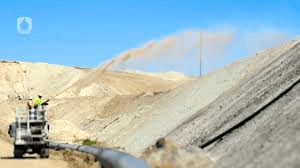
Why in news?
In a surprising development, a company based in Darjeeling, Alt Carbon, is transforming mining dust into a solution that benefits the climate. With investments totaling $500,000 from carbon-credit firms, Alt Carbon employs a geo-chemical technique known as enhanced rock weathering to address atmospheric carbon dioxide (CO2) levels.
Understanding Enhanced Rock Weathering:
- The natural process:
- Over thousands of years, rocks naturally decompose, driven by rain and heat.
- This decomposition results in bicarbonates forming as atmospheric CO2 interacts with minerals like calcium and magnesium.
- These bicarbonates eventually reach the oceans through aquifers, where they can store carbon for millennia.
- Carbon sequestration:
- This process captures and stores atmospheric CO2, aiming to mitigate global climate change.
- Accelerating carbon removal:
- In light of the pressing need to lower atmospheric CO2 levels, as highlighted by the Intergovernmental Panel on Climate Change (IPCC), there is increasing attention on speeding up natural carbon removal methods.
- Enhanced rock weathering (ERW) presents a viable solution.
- What is ERW?
- ERW is a nature-based technique that enhances the natural weathering of rocks to extract CO2 from the atmosphere and combat climate change.
- This method involves spreading finely crushed silicate rocks, such as basalt, across land to increase surface area, thereby hastening the chemical reactions that occur between the rocks, air, and water.
- Benefits:
- Carbon sequestration: ERW effectively helps remove CO2 from the atmosphere.
- Improved soil: It enhances soil pH, nutrient absorption, and overall fertility.
- Reduced ocean acidification: ERW contributes to lessening ocean acidification.
- Challenges:
- One major challenge is making ERW a practical solution for climate change.
- The processes involved in mining, grinding, and transporting the rock consume a significant amount of energy, mainly derived from fossil fuels, which could offset the CO2 benefits.
- Implementing effective enhanced weathering requires vast land areas and collaboration from many farms or coastal regions to achieve significant carbon removal.
- Financially, enhanced weathering tends to be more expensive compared to more direct methods of addressing carbon emissions.
The Innovative Approach of Alt Carbon:
- Using basaltic rock for ERW:
- Basaltic rock, particularly prevalent in areas like Maharashtra and Gujarat due to the volcanic Deccan Traps, is rich in minerals needed for carbon sequestration.
- By grinding this rock into a fine powder, Alt Carbon significantly increases its effective surface area, enhancing the formation of bicarbonates by ten to a hundred times.
- Application in Darjeeling:
- Alt Carbon collects crushed basalt from the Rajmahal mines and transports it to Darjeeling, where it is applied to tea estates.
- This application not only enriches the soil but also accelerates the process of carbon sequestration.
- So far, the company has utilized around 500 tonnes of basalt dust, with a goal to sequester 50,000 tonnes of CO2 in the upcoming years, effectively making mining dust a climate-friendly resource.
Appreciation and Apprehensions of Alt Carbon's Pioneering Method:
- Securing agreements:
- Alt Carbon's innovative strategy has garnered interest from major corporations.
- The company has partnered with Frontier, which includes McKinsey and Alphabet, to secure carbon credits valued at $500,000.
- Additionally, they have teamed up with NextGen to purchase further carbon credits at $200 per tonne.
- Concerns:
- While the fundamental principles of ERW are well established, discrepancies in quantifying sequestered carbon raise concerns.
- This highlights the necessity for precise measurement protocols to ensure accuracy.
Conclusion:
Alt Carbon’s groundbreaking initiatives in utilizing crushed basalt for enhanced rock weathering illustrate a novel approach to carbon sequestration. Moving forward, the company aspires to make significant contributions to combating climate change while also improving agricultural practices.
GS2/Polity
Did Google Violate Antitrust Laws in Epic Battle?
Source: The Hindu
Why in news?
In a landmark decision on October 7, 2024, a U.S. District Court issued an injunction against Google, determining that the company had breached antitrust regulations. This ruling mandates Google to revise its Play Store policies significantly, thus allowing third-party apps greater access and enabling developers to present alternative payment methods within their applications. The case was initiated by Epic Games, which has drawn attention to the increasing apprehensions regarding monopolistic behaviors exhibited by major tech firms.
Background of the Legal Battle:
- The conflict between Epic Games and Google began in August 2020 when Epic launched a direct payment system for its highly popular game, Fortnite, circumventing Google’s required in-app billing process.
- Epic's goal was to evade the 15-30% commission charged by Google on in-app purchases.
- In retaliation, Google removed Fortnite from its app store, which prompted Epic to file antitrust lawsuits against both Google and Apple.
- Epic contended that Google's policies were anti-competitive and that the company had formed exclusive agreements with major developers like Activision Blizzard and Nintendo, which restricted competition by mandating the use of Google's payment system.
Google’s Defense and Appeal:
- Google has appealed the court's ruling, expressing concerns that the decision could jeopardize consumer privacy and security and disrupt the stability within the app ecosystem.
- The company argued that the injunction might hinder developers in promoting their apps and maintaining a consistent user experience.
- Despite these concerns, the ruling is viewed as a pivotal advancement in addressing issues surrounding the app store economy.
Key Differences Between the Google and Apple Cases & the Ruling:
- Both Epic Games and Google faced similar lawsuits, but the results diverged significantly.
- In the Apple case, the court concluded that while Apple was not a monopoly in the app market, it still enforced anti-competitive policies.
- The court directed Apple to permit developers to offer alternative payment methods while requiring Epic to compensate for breaching Apple's developer agreement.
- In contrast, the trial against Google allowed Epic to present extensive evidence regarding Google's exclusive deals with developers, leading to a unanimous jury ruling that confirmed Google's violation of antitrust laws.
Impact on the App Economy:
This ruling is poised to have significant implications for the global app economy, which is valued at over $250 billion.
- Developer-Friendly Terms: Both Google and Apple may be compelled to amend their app store policies to permit developers more freedom and potentially lower the high commissions on in-app transactions.
- Increased Competition: The decision may facilitate the emergence of alternative app stores, diminishing the near-total control that Google and Apple currently maintain over app distribution. This shift could benefit consumers by reducing the costs associated with apps, subscriptions, and in-app purchases since developers would not be obligated to pay exorbitant fees to app store operators.
- Challenges for Smaller Developers: Conversely, smaller developers might face difficulties in gaining visibility for their apps. Currently, developers mainly promote their apps on the Google Play Store and Apple App Store, but with the potential rise of multiple app stores, attracting attention could become more challenging.
Conclusion:
- The lawsuit between Epic Games and Google signifies a crucial moment in the ongoing discourse regarding digital monopolies and app store dominance.
- The injunction against Google is anticipated to foster a more competitive environment and fairer conditions for app developers, potentially transforming the app distribution landscape.
- This ruling, along with similar legal actions, highlights a growing movement to scrutinize large tech companies and promote a more competitive digital market.
- As the case continues through the appeals process, the long-term repercussions for both Google and the broader tech industry will become clearer.
- Nonetheless, it is evident that this legal confrontation has ignited an essential dialogue about fair competition, monopolistic power, and the future of app distribution.
GS3/Environment
What is the Convention on Biological Diversity (CBD)?
Source: Hindustan Times
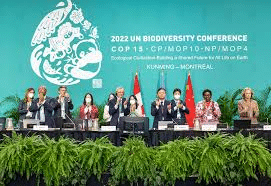
Why in News?
The 16th Conference of Parties (COP16) to the Convention on Biological Diversity (CBD) is set to begin in Cali, Colombia.
About Convention on Biological Diversity (CBD):
- Currently, the CBD has 196 contracting parties, making it the most extensive binding international agreement focused on nature conservation and the sustainable use of natural resources.
- The CBD was opened for signing during the UN Conference on Environment and Development in Rio de Janeiro in 1992.
- It has three main objectives:
- Conservation of biological diversity, which includes genetic, species, and habitat diversity.
- Sustainable use of biological diversity to ensure that natural resources are utilized responsibly.
- Fair and equitable sharing of benefits derived from the use of genetic resources.
- The CBD encompasses biodiversity at all levels, including ecosystems, species, and genetic resources.
- The governing body of the CBD is the Conference of the Parties (COP), which consists of all governments that have ratified the treaty.
- Every two years, the COP convenes to evaluate progress, establish priorities, and agree on work plans.
- The CBD's Secretariat is located in Montreal, Canada.
- To facilitate the implementation of CBD objectives, two binding agreements were adopted:
- The Cartagena Protocol, adopted in 2000 and effective from 2003, regulates the transboundary movement of living modified organisms (LMOs).
- The Nagoya Protocol, adopted in 2010, provides a legally binding framework for accessing genetic resources and ensures fair and equitable sharing of benefits from their utilization.
GS3/Environment
Ramgarh Vishdhari Tiger Reserve
Source: Times of India
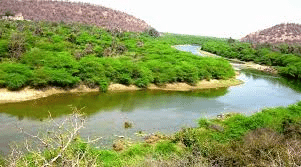
Why in news?
The carcass of a nearly nine-year-old tigress, RVTR-2, was discovered in the Ramgarh Vishdhari Tiger Reserve (RVTR) recently notified in Bundi, Rajasthan.
About Ramgarh Vishdhari Tiger Reserve:
- Location: Situated in the southeastern region of Rajasthan, within the Bundi district, the reserve features both Vindhyan and Aravalli geographical elements.
- Area: The total area of the reserve encompasses 1,501.89 square kilometers, which includes a core area of 481.91 square kilometers and a buffer zone of 1,019.98 square kilometers.
- Adjacent Reserves: The reserve is connected to the buffer area of the Ranthambore Tiger Reserve to the northeast and the Mukundara Hills Tiger Reserve to the south.
- Notification Date: The tiger reserve was officially designated on May 16, 2022.
- River: The Mezi River, a tributary of the Chambal River, flows through the reserve.
- Vegetation:
- The predominant vegetation type in the reserve is Dry Deciduous Forest.
- Topography: The landscape ranges from gentle slopes to steep rocky cliffs, featuring both flat hills of the Vindhyas and sharp ridges of the Aravallis.
- Flora:
- The habitat is mainly characterized by Dhok trees (Anogeissus pendula).
- Other notable plant species include:
- Khair (Acacia catechu)
- Ronj (Acacia leucophloea)
- Amaltas (Cassia fistula)
- Gurjan (Lannea coromandelica)
- Saler (Boswellia serrata)
- Fauna:
- The reserve is primarily home to leopards and sloth bears.
- Other significant animal species include:
- Jungle cat
- Golden jackal
- Hyena
- Crested porcupine
- Indian hedgehog
- Rhesus macaque
- Hanuman langur
GS3/Defence & Security
Parliamentary Committee to Review Armed Forces' Readiness for 'Non-Kinetic Warfare'
Source: Economic Times

Why in News?
The Parliamentary Standing Committee on Defence has prioritized 17 subjects for deliberation, with a key focus on India’s preparedness to counter hybrid warfare. Hybrid warfare describes a conflict in which non-kinetic (non-military) tactics are employed to complement military action.
The Standing Committee on Defence (SCOD)
- The SCOD is responsible for reviewing the Ministry of Defence's activities and ensuring that the armed forces are equipped to handle modern warfare challenges.
About Non-kinetic Warfare
- Non-kinetic warfare encompasses methods of conflict that do not rely on conventional military force or the physical destruction of property.
- This type of warfare utilizes strategies such as cyberattacks, electronic warfare, psychological operations, and economic sanctions to undermine an adversary's infrastructure, economy, or morale.
- It can involve non-military actors and often targets vital infrastructure like power grids, communication networks, and financial systems.
- Examples of Non-Kinetic Warfare
- Russia-Ukraine Conflict: Russia has been accused of implementing extensive cyberattacks alongside traditional military tactics, leading to significant disruptions in Ukraine's power grid and communication systems.
- Israel-Hamas Conflict: Both Israel and Hamas have engaged in information warfare and cyberattacks, with Israel reportedly blocking Hamas's communications and Hamas using propaganda to influence public opinion.
- U.S. Election Interference (2016): Russia was accused of meddling in the U.S. presidential election through disinformation campaigns and cyberattacks on political parties.
- Chinese Cyberattacks on the U.S.: China has been implicated in cyber espionage against U.S. government agencies and companies, aiming to steal sensitive information and technology.
- Pager Blasts in Lebanon: In Lebanon, pager blasts disrupted communication systems, illustrating a localized example of non-kinetic warfare.
- Difference from Kinetic Warfare
- Kinetic warfare involves the use of physical force, including weapons and military personnel, to achieve objectives through direct combat.
- In contrast, non-kinetic warfare achieves its objectives through non-violent means, focusing on weakening or disabling the enemy without direct military engagement.
- While kinetic warfare results in visible destruction, non-kinetic warfare can cause significant disruption without leaving obvious physical traces.
- Threats and Challenges
- Cybersecurity Risks: Cyberattacks can severely disrupt national infrastructure, including power grids and financial systems.
- Information Warfare: The manipulation of public opinion through misinformation poses serious risks to social stability.
- Economic Warfare: Economic sanctions can destabilize a nation's economy without resorting to military conflict.
- Technology Dependence: As systems become increasingly interconnected, the vulnerability to non-kinetic attacks rises.
- Detection and Response: Non-kinetic threats are often harder to detect and defend against than physical attacks, necessitating advanced technology and cybersecurity measures.
The Standing Committee on Defence
- The Committee is constituted under Rule 331 C of the Rules of Procedure and Conduct of Business in Lok Sabha.
- The Ministry of Defence falls under its jurisdiction.
Members and Tenure
- The Committee comprises 31 members: 21 from Lok Sabha and 10 from Rajya Sabha, nominated by their respective speakers.
- The Chairperson is appointed from among the Lok Sabha members of the Committee.
- Members serve a term not exceeding one year.
Functions of the Committee
- To review the Demands for Grants of the Ministry of Defence and report to Parliament.
- To examine bills related to the Ministry of Defence referred to it and make reports.
- To review the Annual Report of the Ministry of Defence and provide feedback.
- To consider National Basic Long-Term Policy Documents if referred by the Speaker or Chairman.
GS3/Environment
Azores Islands
Source: The Print

Why in News?
The regional assembly of Portugal’s Azores Islands has recently approved the establishment of the largest protected marine area in the North Atlantic. This initiative aims to achieve international conservation objectives ahead of schedule.
About Azores Islands:
- Location: The Azores Archipelago consists of nine islands situated in the North Atlantic Ocean.
- Origin: These islands are of volcanic origin, with several having been inactive since their formation. The archipelago is classified as an Autonomous Region of the Azores.
- Geological Features: The islands emerged from the Azores Plateau, located above the Azores Triple Junction, where three tectonic plates—Eurasian, North American, and African—intersect. The Mid-Atlantic Ridge, which lies between the African-Eurasian and North American Plates, crosses the Azores Plateau.
- Arrangement: The islands extend in a northwest-southeast orientation and are categorized into three groups: northwest, central, and eastern.
- Mountain: The highest elevation in the archipelago is Mount Pico, found on Pico Island.
- Climate: The Azores boast an oceanic subtropical climate.
- Fauna: The laurel forests on the islands host a variety of species, including unique plants and animals. Notably, at least two endemic bird species exist here: the Azores bullfinch, which is confined to laurel forests, and Monteiro’s storm petrel.
GS3/Environment
 |
Download the notes
UPSC Daily Current Affairs: 20th October 2024
|
Download as PDF |
Marine Heat Wave
Source: The Wire

Why in News?
Researchers have discovered that marine heat waves (MHWs) occurring deep in the oceans may be significantly under-reported and are influenced by ocean currents.
About Marine Heat Wave:
- A marine heat wave is identified as an extreme weather event.
- It takes place when the surface temperature of a specific ocean region increases by 3 to 4 degrees Celsius above the average for a minimum duration of five days.
- According to the National Oceanic and Atmospheric Administration (NOAA), MHWs can persist for extended periods, ranging from weeks to months, or even years.
Impacts:
- MHWs are prolonged temperature events that can lead to significant damage to marine ecosystems, including:
- Harm to coral reefs, which are vital to marine biodiversity.
- Displacement of marine species, disrupting established food webs.
- These events are increasingly common due to global warming, with significant occurrences noted along:
- Australia's East Coast and Tasmania.
- The northeast Pacific coast and North Atlantic regions.
- Elevated ocean temperatures associated with MHWs can amplify the intensity of storms such as hurricanes and tropical cyclones.
- MHWs promote the proliferation of invasive alien species, which can disrupt local marine food webs.
- Storms traveling over warmer oceans tend to gather more moisture and heat, resulting in:
- Stronger winds.
- Heavier rainfall.
- Increased flooding upon reaching land, leading to greater devastation for coastal communities.
GS3/Health
What is Kala-azar?
Source: The Hindu
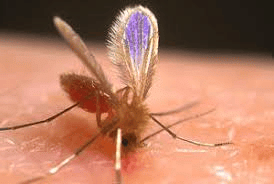
Why in News?
India could be on the verge of eradicating Kala-azar as a public health concern, having successfully maintained the incidence rate below one case per 10,000 individuals for two consecutive years, meeting the WHO criteria for elimination certification.
About Kala-azar:
- Kala-azar, also referred to as Visceral Leishmaniasis (VL), is a serious form of leishmaniasis caused by the protozoan parasite Leishmania donovani.
- This disease is transmitted to humans through the bite of an infected female sandfly, primarily Phlebotomus argentipes in India.
- Kala-azar predominantly affects some of the most impoverished populations globally and is linked to factors such as malnutrition, displacement of people, inadequate housing, weakened immune systems, and limited financial resources.
- Individuals living with HIV and other immunocompromising conditions have a heightened risk of contracting Leishmania infections.
Symptoms:
- The disease manifests with irregular fever episodes, marked weight loss, and swelling of the spleen and liver.
- Severe anemia can occur if the disease remains untreated, potentially leading to death within two years.
Diagnosis:
- Diagnosis involves a combination of clinical assessments and laboratory tests, including parasitological or serological methods such as the rK39 diagnostic kit.
Treatment:
- Several anti-parasitic medications are available that effectively treat leishmaniasis.
GS3/Environment
African Baobab
Source: DTE
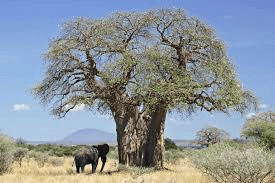
Why in News?
New research by South African ecologists has refuted the claim that the African Baobab (Adansonia digitata) tree is dying due to climate change.
About African Baobab:
- Baobabs are long-lived deciduous trees that can range from small to large, typically growing between 20 to 100 feet tall with broad trunks and compact tops.
- These trees have impressive lifespans, with some living for thousands of years. The oldest known baobab tree, the Panke baobab in Zimbabwe, reached an age of 2450 years.
Distribution:
- Baobabs are solitary trees that thrive in dry, open environments, particularly in the savannas of southern Africa and western Madagascar.
Ecological significance:
- Baobab trees play a crucial role in the dry African savanna ecosystem by maintaining humid soil conditions, facilitating nutrient recycling, and reducing soil erosion thanks to their extensive root systems.
- These trees are capable of absorbing and storing significant amounts of water during the rainy season in their large trunks.
- During the dry season, they produce a nutrient-rich fruit that can grow up to a foot in length, which is essential for various species as it contains tartaric acid and Vitamin C.
- Baobabs not only provide nourishment but also act as a key food source for numerous animals and humans alike, contributing to their survival.
- The fruit of the baobab is recognized for its high fiber content, functioning as a natural prebiotic that supports the growth of beneficial gut bacteria.
- These trees are vital in mitigating the effects of climate change by providing food and shelter, thus supporting biodiversity in their habitats.
GS1/Indian Society
What is Vitiligo?
Source: DTE

Why in News?
A new Kannada film is attempting to take the veil of stigma off from a vitiligo disease that is usually the subject of stereotypes and ignorance in India.
About Vitiligo:
- Vitiligo is a chronic skin condition characterized by the destruction of melanocytes, the cells that produce melanin.
- This disorder leads to the formation of depigmented patches on the skin, hair, and even within the lining of the mouth.
- While the exact cause of vitiligo is not fully understood, it is believed to result from a combination of autoimmune reactions, genetic factors, and environmental influences.
- In cases of autoimmune vitiligo, the immune system mistakenly targets and damages melanocytes, causing a gradual loss of skin pigmentation.
- The condition typically begins with small white patches that may expand over time.
- Dermatologists suggest that factors such as oxidative stress, physical injuries, severe sunburn, or exposure to certain chemicals may act as triggers for vitiligo.
- Vitiligo can develop at any age, but it is most frequently diagnosed in individuals under 30 years old.
- Globally, vitiligo affects between 0.5% and 2% of the population, amounting to an estimated 100 million individuals living with this condition, impacting both men and women equally.
Treatment:
- Currently, there is no permanent cure for vitiligo.
- However, various treatment options are available to help manage symptoms and restore skin pigmentation.
- These treatments include topical corticosteroids, calcineurin inhibitors, and phototherapy, which aim to slow down depigmentation and promote the regeneration of melanocytes.
|
39 videos|4544 docs|971 tests
|
FAQs on UPSC Daily Current Affairs: 20th October 2024 - Current Affairs & Hindu Analysis: Daily, Weekly & Monthly
| 1. What is the significance of the Kameng River in Arunachal Pradesh? |  |
| 2. How does mining dust impact climate solutions? |  |
| 3. What were the key issues in the antitrust case against Google? |  |
| 4. What is the Convention on Biological Diversity (CBD)? |  |
| 5. What are the key features of the Ramgarh Vishdhari Tiger Reserve? |  |


























